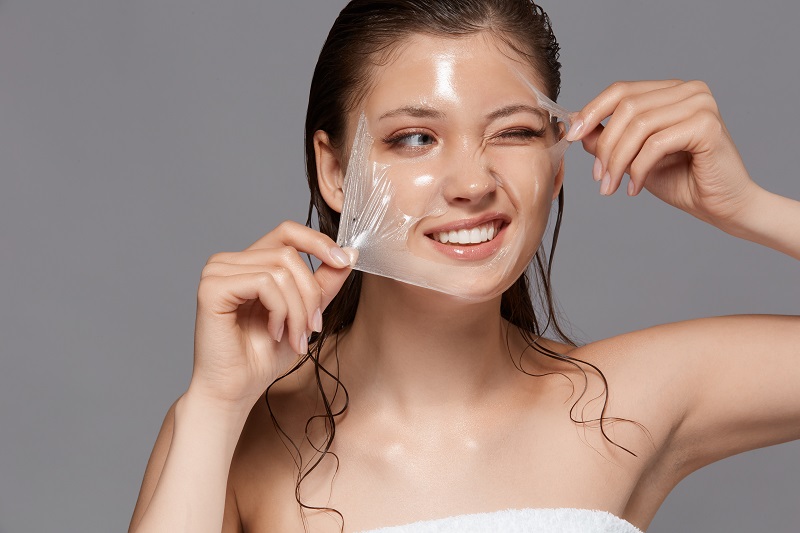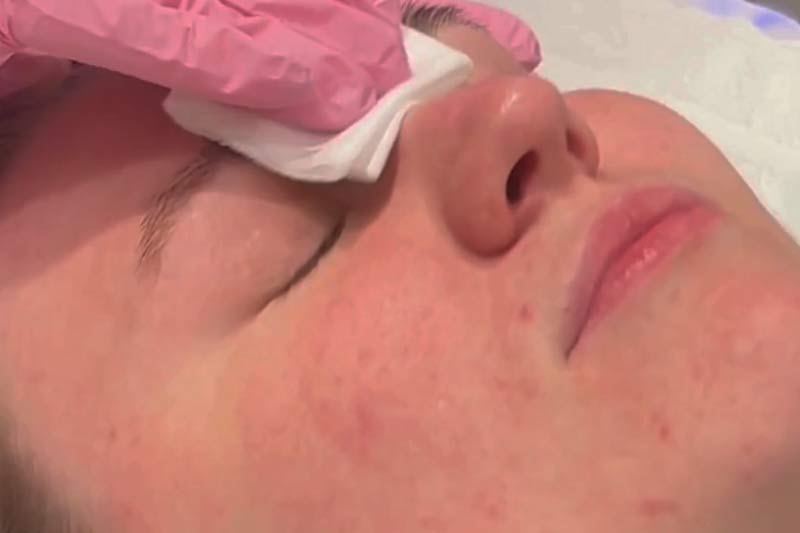Chemical peels are the most popular cosmetic procedures after Botox and dermal fillers. They are anti-aging, skin resurfacing treatments that provide a range of benefits, including smoothed wrinkles, brighter skin tone, improved skin texture, and reduced scars and blemishes.
This article breaks down the three main chemical peel types and provides information on the most common chemical peel acid solutions. Knowing how chemical peels work will help you determine which type is suitable for you.

Types of Chemical Peels
Chemical peels vary in strength and how deeply they penetrate the skin. The following factors determine the potency of the chemical peel:
- pH level – The acidity of the peel solution. A lower pH means a stronger, more acidic peel with deeper penetration. For instance, a 20% glycolic acid peel with a low pH will be stronger and penetrate deeper than a 30% glycolic acid peel with a higher pH.
- Percentage of chemical acids – The concentration of the active peeling agent. Generally, a higher concentration indicates a stronger peel, penetrating deeper into the skin. However, a lower-concentration peel with a very low pH can still be quite potent.
- Molecular size – Determines how easily the acid molecules penetrate the skin barrier. Acids with smaller molecules (like glycolic acid) penetrate deeper and faster, making them suitable for addressing issues such as wrinkles and texture concerns. Larger molecules (like lactic acid) penetrate more slowly and are often preferred for sensitive skin.
The patient’s medical provider creates a customized chemical peel plan based on their skin type, skin concern, and aesthetic goals.
Light Chemical Peels
Light chemical peels are superficial peels that exfoliate the uppermost skin layers (epidermis) and speed up skin cell turnover to improve various skin concerns.
How Does a Light Chemical Peel Work?
Light peels are the gentlest type of chemical peels. They contain low concentrations of mild acids that break down the cells on the skin’s surface and exfoliate the outermost skin layer. The treatment stimulates the body’s natural healing mechanism, increasing collagen production and prompting the growth of healthy, new skin.
A series of four to six treatments is typically required for effective results.
Light Chemical Peel Formulation
Light chemical peels usually contain alpha hydroxy acids (AHA) and/or beta hydroxy acids (BHA). They are typically formulated with large-molecule acids, like lactic acid, or lower concentrations of smaller-molecule acids, such as glycolic acid.
Glycolic acid is an excellent exfoliator because it consists of small molecules that deeply penetrate skin layers without causing irritation. The exfoliation stimulates collagen and elastin production, resulting in a smoother, younger-looking complexion with less visible imperfections.
Light Chemical Peel Benefits
Light peels provide the following benefits:
- Improved skin cell turnover
- Improved skin texture
- Reduced fine lines
- Decreased discoloration
- Brighter complexion
Light Chemical Peel Side Effects
The treatment doesn’t require any recovery time because the acids are used in low concentrations. Patients may experience slight redness and swelling that disappear within seven days.
Light Chemical Peel Aftercare
Medical providers advise patients to follow these aftercare tips to ensure the best results.
- Avoid extended exposure to the sun and other sources of heat.
- Avoid strenuous exercise for 24 hours.
- Don’t rub or scratch the treated area.
- Moisturize the treated area with a gentle moisturizer.
- Avoid harsh skincare products.
Ideal Candidate for Light Chemical Peel
The ideal candidate for light chemical peels has mild skin concerns that the treatment can improve, such as post-inflammatory dark spots, fine lines, and tired, dull skin. The treatment is generally safe for all skin types and tones, including sensitive and darker skin.
Note: Check out our list of products for sensitive skin.
Light Chemical Peel Cost
Light chemical peels at Vibrant Skin Bar cost $99. The total treatment cost depends on the number of required sessions for the patient’s unique skin concern.
Medium Chemical Peels
Medium chemical peels penetrate through epidermis into the upper dermal layers. They are more invasive than light peels and achieve more significant results.
How Does a Medium Chemical Peel Work?
Like light peels, medium chemical peels exfoliate dead skin cells, oil buildup, and dirt, and stimulate collagen production. They penetrate deeper than light peels, addressing more severe skin damage, including moderate acne scars.
Patients typically need at least 1-3 sessions to see results.
Note: Learn about different types of acne scars and find out what is the best chemical peel for acne scars.
Medium Chemical Peel Formulation
Medium chemical peels often use a combination of different acids to achieve the desired penetration. They are usually made up of different concentrations of trichloracetic acid (TCA), glycolic acid, or Jessner’s solution (a combination of salicylic acid, lactic acid, and resorcinol).
Medium peels have a lower pH, allowing for deeper penetration than a light peel.
Medium Chemical Peel Benefits
Depending on the medium peel’s acid concentration, it can effectively treat the following skin issues:
- Acne
- Mild and moderate acne scars
- Deep wrinkles
- Excess sebum production
- Hyperpigmentation
- Uneven skin
Medium Chemical Peel Side Effects
Medium peels are more invasive than light peels and can cause more severe skin reactions, including:
- Stinging
- Burning
- Redness
- Swelling
- Dryness
- Skin peeling
- Crusting
Most side effects after medium peels go away within two weeks, but redness may last for months.
Note: For patients with darker skin, the risk of temporary or permanent hyperpigmentation is higher, especially with medium and deep peels. To mitigate this, a provider might use a combination of low-strength peels or recommend specific skin care to control pigment production.
Medium Chemical Peel Aftercare
Medium chemical peels require extended aftercare compared to light peels due to deeper product penetration and more time needed for recovery. Patients may need to avoid the sun, harsh skincare products and treatments, and makeup for weeks. The provider may recommend antiviral medication and specific soothing skincare products.
Ideal Candidate for Medium Peels
Medium chemical peels are suitable for patients with acne, mild to moderate acne scars, oily skin, wrinkles, dark spots, and other signs of sun damage. Patients with uneven skin tone and texture experience significantly smoother skin after the treatment.
Medium Chemical Peel Cost
Medium peels at Vibrant Skin Bar cost $125. The total treatment cost depends on the patient’s skin concern and the number of required sessions.
Deep Chemical Peels
Deep chemical peels penetrate all skin layers and dramatically transform the skin. They are more invasive than light and medium peels and require medical supervision.
How Does a Deep Chemical Peel Work?
Deep peels use aggressive chemicals to penetrate the reticular dermis, boost collagen production, and treat severe skin damage. The treatment requires sedation and local anesthesia and recovery time may extend to several months. One treatment is enough to provide results that last for years.
Deep Chemical Peel Formulation
Deep peels use the highest concentration of the strongest, most aggressive chemicals, such as carbolic (phenol) acid, a combination of phenol and resorcinol or salicylic acid, or TCA exceeding 50%. Deep peels have very low pH, making them extremely acidic and able to cause significant, controlled tissue injury.
Deep Chemical Peel Benefits
Deep peels provide visible anti-aging effects and treat severe skin concerns, including the following:
- Severe atrophic scars
- Deep wrinkles
- Age spots
- Melasma
- Loss of skin elasticity
- Spider veins
The results last for years with only one treatment.
Deep Chemical Peel Side Effects
Common reactions to deep peels include:
- A burning sensation
- Redness
- Swelling
- Peeling
- Blistering
Rare, more severe side effects include:
- Permanent scarring
- Permanent pigmentation changes
- Inability to tan normally
- Infection
- Organ (heart, liver, kidney) damage from phenol toxicity
Deep peels can also damage the structural integrity of the dermal-epidermal junction (DEJ), which is vital for skin strength and elasticity. Damage to this junction can lead to long-term issues such as increased susceptibility to skin laxity and accelerated aging.
Skin experts often recommend laser resurfacing instead of deep chemical peels due to the intensity of the treatment and possible side effects.
Deep Chemical Peel Aftercare
Recovery time after deep peels may extend to several months. Besides avoiding the sun, strenuous exercise, and harsh skincare products, deep peel aftercare also includes:
- Taking antiviral medications
- Wearing bandages
- Applying heavy-duty ointment to the treated area
Ideal Candidate for Deep Peels
People with deep wrinkles, significant sun damage, atrophic scars, and blotchy, rough skin can benefit from deep peels. Because the treatment is so intense, the medical provider needs to carefully examine the patient and determine if the treatment is suitable for them.
Deep Chemical Peel Cost
Deep peels may cost several thousand dollars because they carry more risk than light and medium peels and include the additional costs of anesthesia, prescription medication, and facility costs.
Which Chemical Peel Should You Choose?

There is no universal best chemical peel. Each patient requires a different approach, depending on their skin type and concern.
For example, patients with darker skin tones should avoid phenol peels because they may permanently lighten their skin. These patients are more likely to benefit from medium peels with weaker TCA concentrations, medium peels with glycolic acid, or superficial peels with mandelic acid.
Patients with acne-prone skin are often treated with light BHA peels, while patients with deep acne scars may only need spot treatment with TCA.
The following table summarizes the key advantages and disadvantages of each chemical peel type.
| Pros | Cons | |
|---|---|---|
| Light Peels | Minimally invasive. No downtime. Safe for all skin types, including sensitive and dark skin. | Address mild skin concerns, like dull skin and fine lines. |
| Medium Peels | Address more severe skin concerns, including acne scars and wrinkles. | Longer downtime and higher risk of pigment changes than after light peels. |
| Deep Peels | Provide dramatic rejuvenation effects comparable to those of surgery. The results last for years. | Long recovery and higher risk of severe side effects. Not suitable for dark skin tones. Much more expensive than light and medium peels. |
The best way to determine the right chemical peel for your skin is to consult an experienced skin professional with a medical degree. This will ensure the maximum safety and effectiveness of the procedure.
Vibrant Skin Bar skin experts offer professional light chemical peels to resurface a brighter, glowing complexion without downtime.
Our medium peels are designed for patients who want to see more dramatic anti-aging effects on their skin tone and texture.
Regardless of the type of peel you choose, it is essential to use sunscreen post-treatment to avoid damaging the sensitive, newly resurfaced skin.
Chemical Peel Types FAQ
Many chemical peel patients want to know more about chemical peel types and their frequently asked questions include the following.
What Is the Most Effective Chemical Peel?
The effectiveness of a chemical peel depends on the patient’s unique skin concern, skin type, and their goal. While deep peels can provide the most impressive results, they may also cause permanent damage to sensitive skin or darker skin tones. The most effective chemical peel is customized by an experienced medical provider for a particular patient.
What Is the Most Aggressive Chemical Peel?
Deep peels are the most aggressive. They typically contain a high concentration of phenol acid, which penetrates the deepest skin layers.
What Chemical Peel Has the Most Downtime?
Deep peel requires the longest recovery (downtime) period because it causes redness, swelling, peeling, and discomfort that last for weeks or months.
Conclusion
Chemical peels are among the most versatile cosmetic treatments, providing a wide range of skin benefits – from a reduction in wrinkles and age spots to youthful, glowing skin.
To achieve your desired look, make sure you find a reputable, board-certified medical provider who will create a customized chemical peel for your particular skin concern.


